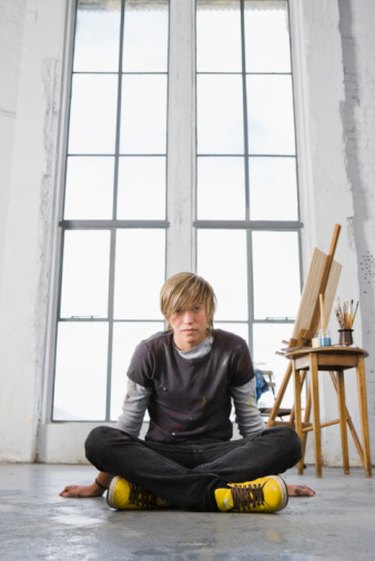
If you ask 100 people to describe a master artist, you'll probably get 100 different answers. Art itself has infamously escaped definition and the question of "good" and "bad" art is still up for debate. Nevertheless, being a master of your craft does have a few hard and fast rules that have endured throughout the years, because the successful execution of technique can be objective. Everything else is just a matter of opinion.
Eccentricity
Video of the Day
Psychologist William James wrote that when superior intellect and psychopathic tendencies combine, the result is likely to be an artistic genius. Creativity, in general, is marked by the combination of rational and irrational thoughts, and turning this into art requires artists to go deeper and deeper into the unknown to create. Michelangelo, for example, used to beat and scream at his statues as if they could respond. According to Socrates, it is impossible to approach art " . . .untouched by the madness of the muses."
Video of the Day
Groundbreakers
Master artists do not become master artists by sticking to the status quo. Historically, their work has always met with some sort of controversy, but has always stretched the boundaries of art. Marcel Duchamp began using everyday items, such as a toilet, in its original form. Gradually the term "ready-made art" or "found art" entered the lexicon of the art world because of him. Uniformly, master artists have expanded the definition of art and changed the way people interpret art.
Technique
Mastering technique gives you the freedom to express yourself, as well as bring about the accurate visual effects that render some paintings to be so lifelike. The Dutch artist Vermeer devoted himself to the painstaking process of doing small drawings to work out the specifics of a painting, under-painting the canvas to achieve the right background color and then restricting himself to small areas of the painting at one time. These were methods usually learned during an apprenticeship in a Master Artist's studio, from a more experienced artist.
Integrity
Integrity refers to a sense of wholeness and completion and master artists' are usually praised for their ability to produce works that have undeniable individuality. An artist's integrity also involves turning away from pressing personal issues to pursue a life of making art. Paul Gauguin left personal responsibilities to move to Tahiti and paint. Part of the value of the works of master artists comes from the fact that they produced work under circumstances that were defined by them, and they go beyond aesthetics.
- Leading Today; The Teacher-A Master Artist; Kelly Thomas Mango
- Bryn Mawr College; Creativity And Irrational Forces: Eccentric Artists And Mad Scientists; Laura Gosselink
- Current; 10 Most Eccentric Artists To Ever Live; April 2010
- Art Revived: Top 5 Most Controversial Art Pieces Of All Time
- Essential Vermeer: Vermeer Painting Technique
- Stanford University; Integrity; August 2008